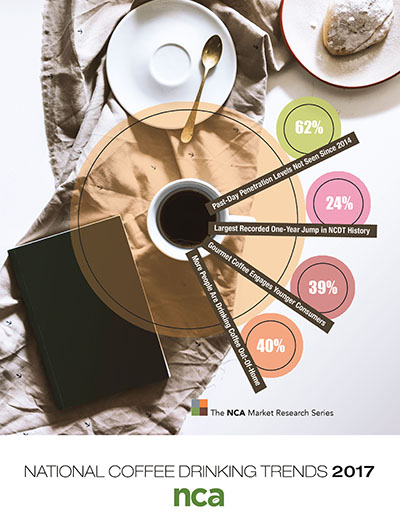
By Kyra Auffermann, NCA
Today’s “typical” cup of coffee is anything but – it may not even be a cup.
Innovation is fueling growth across the gourmet coffee segment (aka specialty coffee), according to the new NCA National Coffee Drinking Trends Report 2017, released at the NCA 2017 Annual Convention in Austin on March 25, presented by Michael Edwards, Dig Insights.
The latest data shows a market shift toward high-quality, premium beverages, with younger demographics driving this change.
So what does this mean for the coffee industry? Here are the top consumption trends, based on the latest market data.
GOING GOURMET
“Coffee” used to be associated with a traditional percolated brew, consumed at home at the breakfast table. Now the perception of coffee has expanded to include an afternoon nitro cold brew while working at a cafe, or a bottle from a vending machine in the train station after work.
For the first time in the NCDT’s 67-year history, more than half (59%) of coffee cups consumed daily are now classified as gourmet, versus 46% in 2012.
Traditional drip brewers are still the most common method of preparation – but barely. In fact, 2017 is the first year where fewer than half of daily coffee consumers drank coffee prepared with a drip brewer on a past-day basis (46%).
According to the report, “This represents a gradual but fundamental shift in the American coffee landscape.”

via Dig Insights
To reflect the emerging popularity of premium beverages among mainstream consumers, we added the new category “Non-Espresso Based Beverages” to the 2017 NCDT. This includes beverages such as cold brew, nitro, or frozen blended coffee, and is generally congruous with the “specialty coffee” designation.
These drinks predominantly engage consumers under 35 years, suggesting potential long-term growth opportunities for the industry. Younger generations may be drinking less coffee than older adults, but they’re drinking better coffee.
And they’re definitely drinking it differently.
WHEREVER, WHENEVER

This cat is probably a Millennial. (via Giphy)
According to the NCDT data, we’re drinking more coffee prepared out-of-home – reaching a high of 46% in 2017.
Where people drink their coffee is strongly correlated to age. People 65 years and older are the most likely to have coffee exclusively at-home. Meanwhile, coffee drinkers under 35 years are nearly one-third more likely to drink coffee from a café or donut shop.
(During his presentation, Michaels said that one of the primary reasons younger demographics gave for drinking coffee at home was “something to do in front of the computer.” Obviously.)
Drinking more coffee out-of-home may contribute to younger demographics’ interest in new flavors and preparation methods, because of increased exposure to new beverages and trends.
It’s important to note that this shift in place is not only a question of preference, but also a reflection of our increasingly mobile (and WiFi-dependent) lifestyles: Ultimately, people drink coffee where and when works for them. With so many options available, sometimes “better” means easier. Meet your consumer where they are.
This may be a strategic opportunity for brands to introduce new beverages and brewing methods into consumers’ homes. Reinforce positive rituals, introduce innovation, and emphasize quality. Remember that consumers don’t consider coffee a utilitarian necessity to endure, but rather a small luxury to be savored – even celebrated (and Instagrammed).

READY FOR RTD?
The elusive intersection of convenience and quality helped drive the popularity of the single serve brewer phenomenon, which remains the second most common brewing method in 2017.
Now, we’re seeing in the rise of ready-to-drink (RTD) products, which offer café taste on-demand. [This is covered more extensively in the NCA’s all-new Generational Report: Coffee Through the Ages]
The RTD consumption is currently highest among 13-18 year olds. However, as more consumers discover third-wave coffee culture, the demand for niche beverages will continue to move towards mainstream. This trend will enable smaller brands to reach a wider audience, and introduce gourmet coffee drinks to people who may not have been exposed to them otherwise.
Younger consumers in general feel less confident brewing their own coffee. Edwards said that a growing percentage of consumers who use a single serve brewer only know how to prepare coffee with that method. And, 13-24 year old coffee drinkers are more likely to purchase coffee that provides instructions for different brewing methods.
Additionally, the RTD market offers a range of gourmet options that appeal to younger audiences – from cold brew to canned espresso. However, single-serve machines address the need for convenience at home, but primarily deliver traditional coffee, highlighting a potential market gap for specialty coffee companies.
COFFEE AND HEALTH
There has been an overwhelming amount of positive scientific research on the potential health benefits of regular coffee consumption, from protecting your liver to improved cognitive function. Last year, IARC issued an unprecedented reclassification of coffee, saying that the beverage could no longer be considered a possible carcinogen – and may even reduce the risk of certain cancers.
Yet the association between coffee and health is weakening among consumers. Only 16% of consumers report hearing information about the health benefits of coffee, down from 20% in 2015. And 66% are concerned with limiting their caffeine intake.
Reinforcing the (many) health benefits of coffee consumption – both among consumers and medical professionals – may be a communication opportunity for the industry.
DIGGING DEEPER
The 2017 National Coffee Drinking Trends report shows that the coffee market is undergoing a period of transformation, driven by the demands of a new generation and the influence of new innovations.
To learn more, register now for the upcoming NCA webinar with Michael Edwards, March 30, 1-2 pm EST (free for NCA members).
The full report is available for purchase on the NCA website, along with the new NCA Generational Report.
Read the NCA’s official NCDT 2017 news release.
What do the latest coffee consumption trends mean for the future of the industry? Share your comments below.

Pingback: Coffee Shops Are On the Rise | The First Pull